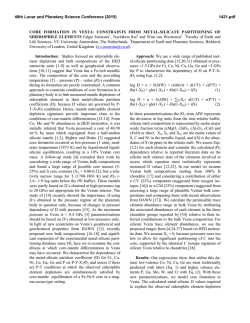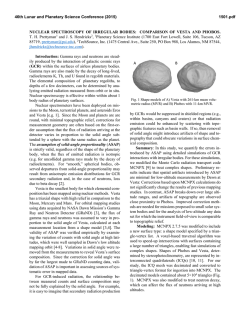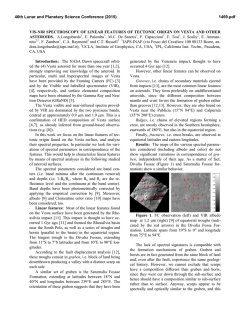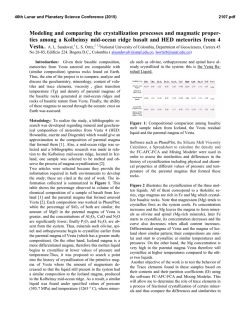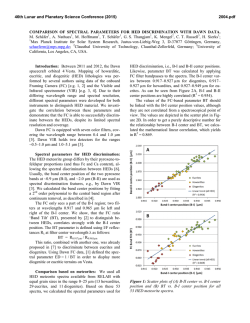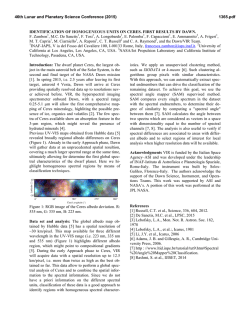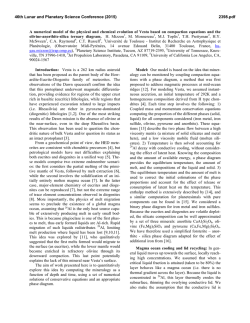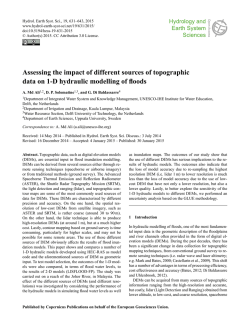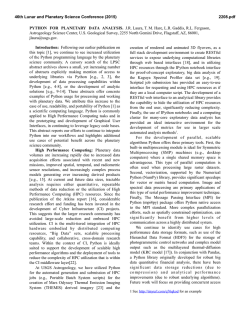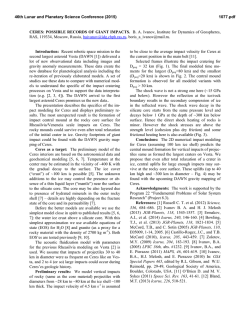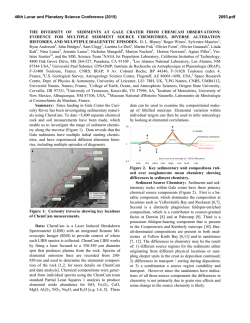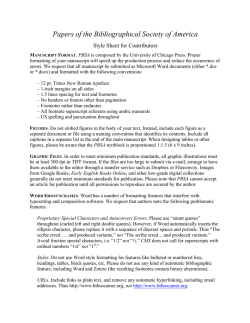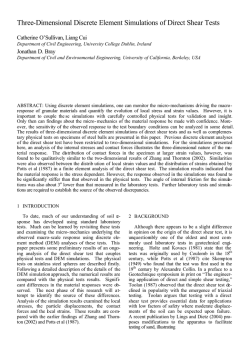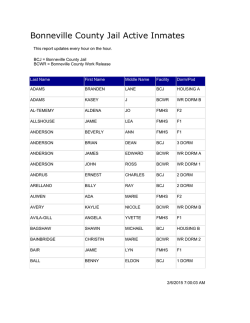
2955
46th Lunar and Planetary Science Conference (2015) 2955.pdf HAYABUSA AND DAWN IMAGE CONTROL FROM GENERATION OF DIGITAL ELEVATION MODELS FOR MAPPING AND ANALYSIS. Kris J. Becker1, Robert W. Gaskell2, Lucille LeCorre2, Vishnu Reddy2, 1U. S. Geological Survey, Astrogeology Science Center, 2255 N. Gemini Dr., Flagstaff, AZ, 86001 ([email protected]), 2Planetary Science Institute, Tucson, AZ, 85719. Introduction: Images returned from the Hayabusa [1] and Dawn [2] missions have been used to create digital elevation models (DEM) [3,4] from the same or similar stereophotoclinometry (SPC) technique [5]. Image data from the Asteroid Multiband Imaging Camera (AMICA) on Hayabusa spacecraft and the Framing Camera (FC) on Dawn were used in the generation of shape models for asteroids (25143) Itokawa and (4) Vesta, respectively. These DEMs will be used to create International Astronomical Union (IAU) compatible, high quality orthorectified color maps of Itokawa and Vesta for photometric and mineral composition analysis. The maps, created from the same images used to create the DEMs, will be highly correlated with the DEM through image control using leastsquares adjustment techniques. For our work, we will evaluate the individual image control for accuracy and color set alignment of global maps for analysis purposes. A small comparison study will be made with results using Integrated Software for Imagers and Spectrometers (ISIS) [6] control techniques [7] to assess the need for higher refinement in the image position and pointing to achieve the required precision. ISIS has camera models for both the AMICA and FC instruments. This work will result in refined Navagation and Ancillary Information Facility (NAIF) Camera Kernel (CK) and Spacecraft and Planet Kernel (SPK) datasets to be made public through distribution by the Planetary Data System (PDS). Image Control: Critical to the accuracy of any DEM created from planetary images is control of the image set using rigourous photogrammetric, stereo and/or photoclinometry techniques. Although the techniques are varied to create DEMs, the foundation of all approaches is image control. This is required since there are uncertainties in the CK and SPK kernels provided by navigation and mission operations teams. The objective of image control is to re-establish the exterior orientation (position/pointing) of the images at the time of exposure. Proper alignment of surface features is critical in establishing ground truth for the matching of common features among images. In the SPC process used by Gaskell to derive DEMs, SUMFILES for each image are created that contain the corrected spacecraft position and pointing vectors in body-fixed coordinates. These data are used to create new SPK and CK kernels, respectively. These kernels will then be used by the ISIS spiceinit application to apply the updated ephemeris for each image. Note a requirement for this approach is that every image used in the maps must also be used in the creation of the DEM. If this requirement cannot be met, then additional image processing techniques may be required in order to properly align color image data sets. The images are then projected to cartographic maps using ISIS’ efficient orthorectification algorithms [8]. Hayabusa Data Sets: The Hayabusa AMICA instrument collected 1,662 images of which 1,319 images are of asteroid Itokawa. The DEM created from these images [3] is archived at the PDS Small Bodies Node (http://sbn.psi.edu/pds/resource/itokawashape.html) and is shown in Figure 1. Seven band global color maps will be created from the AMICA data set using SPK and CK kernels created from the DEM process. Figure 1. Rendering of the DEM of asteroid Itokawa. Dawn Data Sets: The Dawn FC image data set is comprised of images acquired during the High Altitude Mapping Orbit (HAMO) 1 and HAMO2 phases of the Vesta mapping encounter. HAMO1 contributes 4,425 color frame sets and HAMO2 has 1,322 color sets. These data sets will be used to create a fully restored global seven color band map. In addition to global color maps, we will create a global map with the FC clear filter. HAMO1 has 2,557 and HAMO2 provides 2,785 clear filter images for this map. 46th Lunar and Planetary Science Conference (2015) The DEM used for orthorectification of all these maps is a derivation of the Gaskell 2013 final DEM, shown in Figure 2, and is available at the Dawn Public Data site (http://dawndata.igpp.ucla.edu/tw.jsp?section=geometr y/ShapeModels/GASKELL_CLAUDIA_2013_02_13). However, this DEM is in the Claudia [9] coordinate system and will require additional processing to convert it to the IAU coordinates. Figure 2. Vesta DEM in Claudia coordinate system serves as the basis for Dawn FC processing. Summary: The Hayabusa AMICA and Dawn FC DEMs are derived using the SPC shape model process. Inherent in this process is image control of the complete data sets used in creating high quality, orthorectified color cartographic maps for data analysis. The similarity of the objectives of these two efforts provides us the opportunity to derive one solution that satisfies objectives for both projects. The results of this work will be made available through the PDS. Acknowledgements: The Hayabusa component of this work is funded by the NASA Planetary Mission Data Analysis Program Program Grant NNX13AP27G (PI: Reddy) and Dawn component is funded by NASA Planetary Mission Data Analysis Program Program Grant NNX14AN16G (PI: Le Corre). References: [1] Fujiwara A. et al. (2006) Science, 312, 1330-1334. [2] Russell C.T. et al. (2011) Science 336, 684-686. [3] Gaskell R.W. (2006) LPSC XXXVII, Abstract #1876. [4] Gaskell R.W. (2012) AAS/DPS 44, Abstract #209.03. [5] Gaskell, R.W. (2006) LPSC XXXVII, Abstract #3001. [6] Anderson J. A. et al. (2004), LPSC abstract #2039. [7] Edmundson K.L. (2012) ISPRS, PRSSIS, 1-4, 203-208. [8] Anderson J.A. (2013) LPSC XLIV, Abstract #2069. [9] Li J. (2012) PDS, (http://sbn.psi.edu/archive/dawn/fc/old/DWNVFC2_1 A/DOCUMENT/VESTA_COORDINATES/VESTA_ COORDINATES_120918.PDF) 2955.pdf
© Copyright 2024
